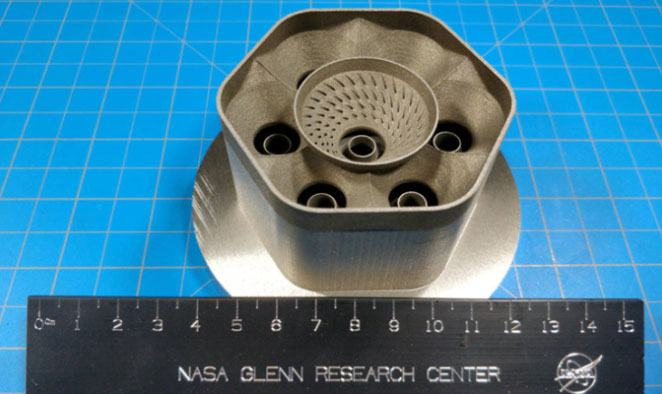NASA creates a new alloy that increases durability by 1,000 times
The GRX-810 alloy, developed using modeling and 3D printing, can withstand temperatures of more than 1,000 degrees Celsius.
NASA has developed a new alloy for use in aeronautics and space exploration, which is 1,000 times stronger than the most modern alloys available, Interesting Engineering reported on April 20.

The turbine engine combustion chamber is 3D printed in alloy GRX-810 at NASA's Glenn Research Center.
The space agency is always looking for materials that can withstand the harsh conditions of launch as well as the cold of space. The new material, GRX-810, is an oxide-dispersion-enhanced alloy (ODS), which can withstand extremely harsh conditions before reaching the breaking point.
During fabrication research, NASA uses materials modeling to determine which metal combinations might yield the best results. In the past, experts used to use a process of "trial and error" to find suitable new materials. This process usually takes many years.
By combining materials modeling with 3D printing, NASA is able to quickly identify the required components of the desired alloy and produce it in a short time. The modeling method allowed NASA to find the ideal composition of the alloy after only about 30 simulations.
"What used to take years of trial and error now only takes weeks or months to figure out," said Dale Hopkins, NASA's deputy project manager for Transformation Technologies and Instruments.
The new alloy can withstand heat up to 1,093 degrees Celsius. At this temperature, it has twice the fracture resistance, 3.5 times more ductility and ductility, and its strength under pressure at high temperature increased 1,000 times compared with current alloys.
"In the past, increasing tensile strength (the ability to withstand force when stretched without breaking) often reduced the ability to stretch and flex. That's why our new alloy is so remarkable." Hopkins added. According to NASA, the flexibility of the new material will lead to major improvements in performance.
In addition, the use of 3D printing technology also saves time and costs compared to the traditional process. "This is a revolutionary breakthrough in materials development. New stronger and lighter materials are key as NASA sets out to transform future flight," Hopkins said.
- New aluminum alloy fabrication withstands 400 degrees Celsius
- The first time to create glass alloy
- Alloys 'transformed' 10 million types
- Concrete increases durability when 'feeding' marine life
- Polymer concrete: concrete solution
- The new method increases the durability of glass
- New alloy super durable, corrosion resistant
- India successfully developed alloys for missiles
- NASA creates a cold point 10 billion times more than a vacuum
- Scientists successfully developed transfigured liquid metal
- Aluminum 7075 can be welded, the future of cars and aircraft will be more durable and fuel efficient
- Heavy antibiotic use increases the risk of lymphoma
 Van Allen's belt and evidence that the Apollo 11 mission to the Moon was myth
Van Allen's belt and evidence that the Apollo 11 mission to the Moon was myth The levels of civilization in the universe (Kardashev scale)
The levels of civilization in the universe (Kardashev scale) Today Mars, the sun and the Earth are aligned
Today Mars, the sun and the Earth are aligned The Amazon owner announced a secret plan to build a space base for thousands of people
The Amazon owner announced a secret plan to build a space base for thousands of people